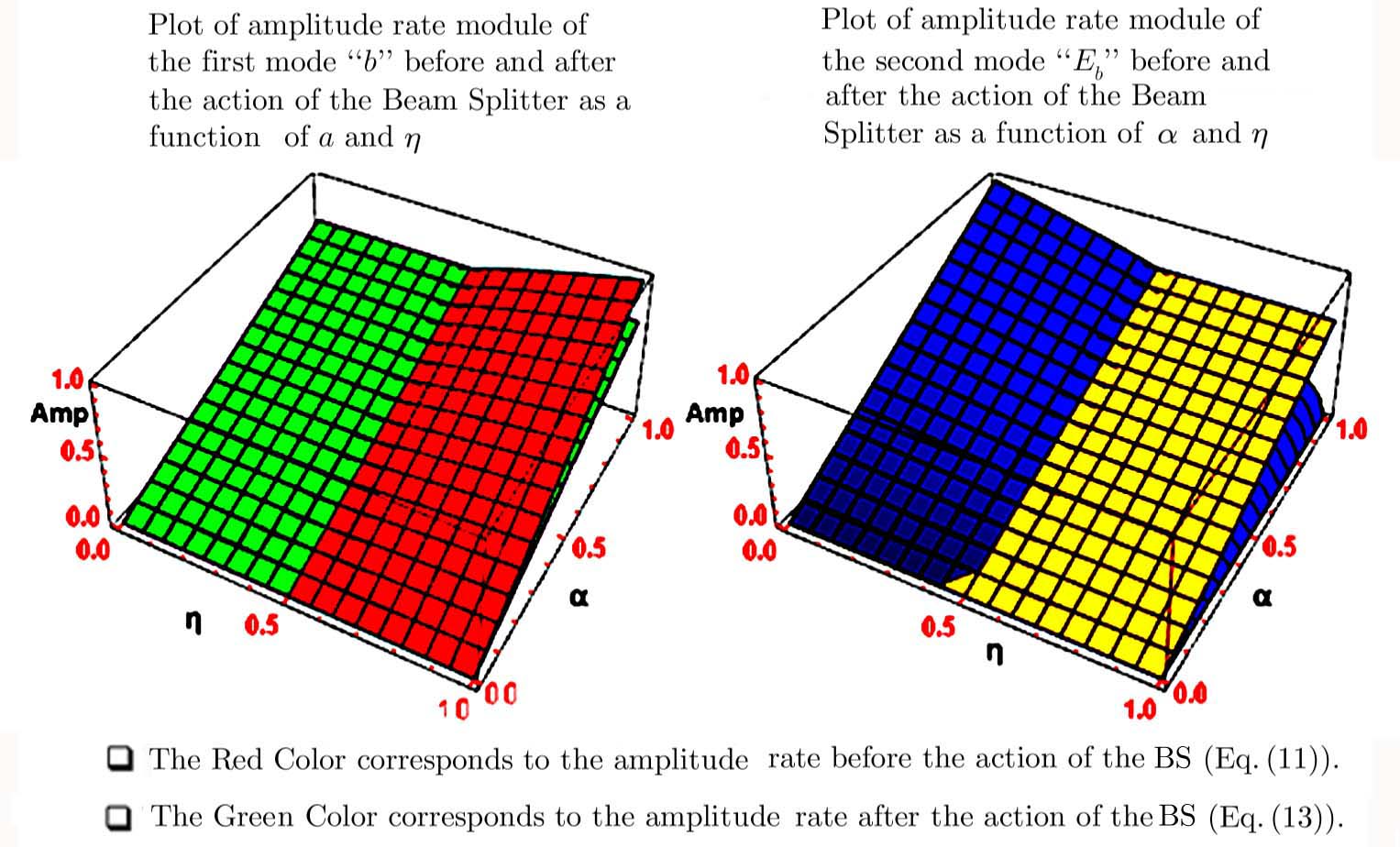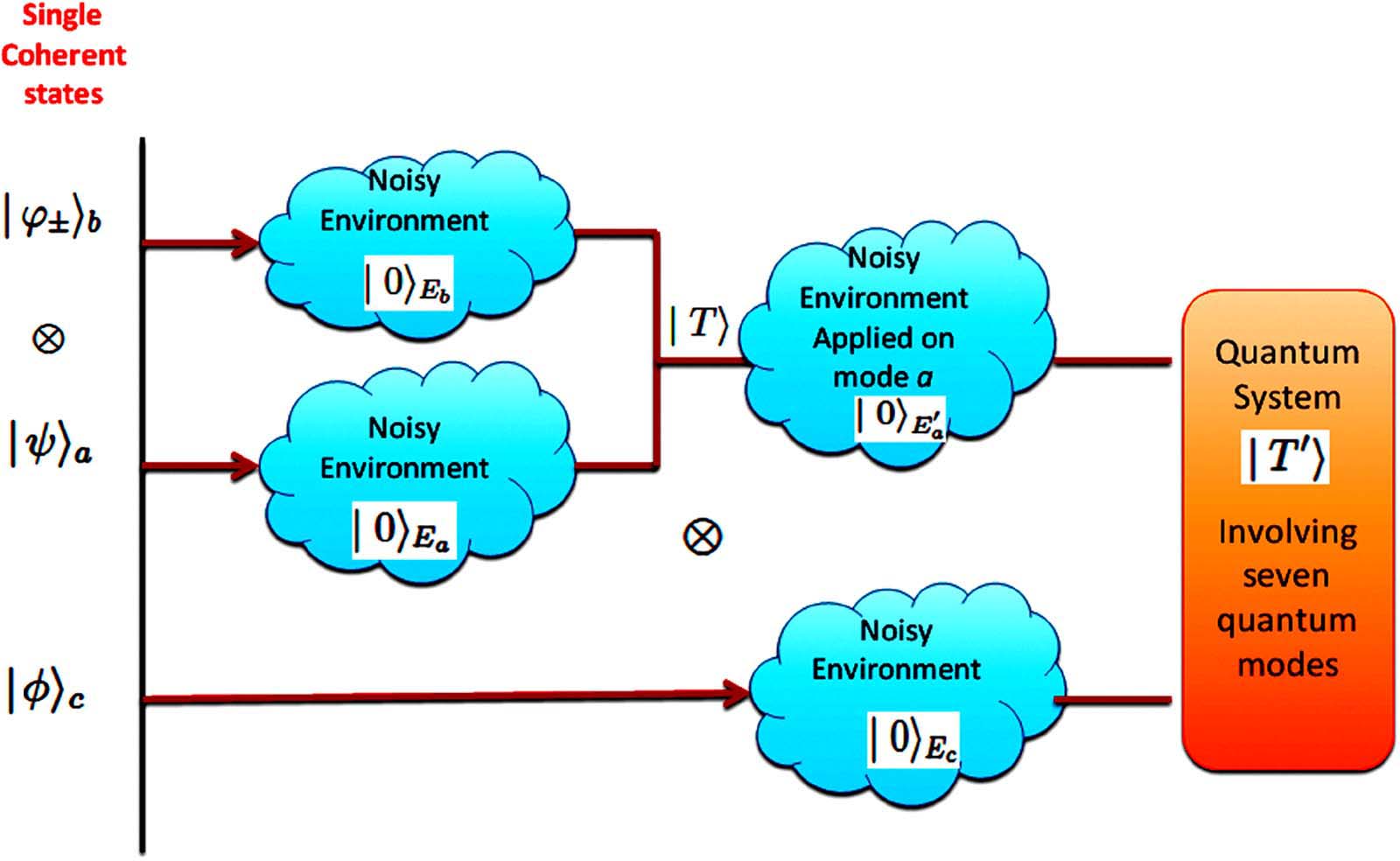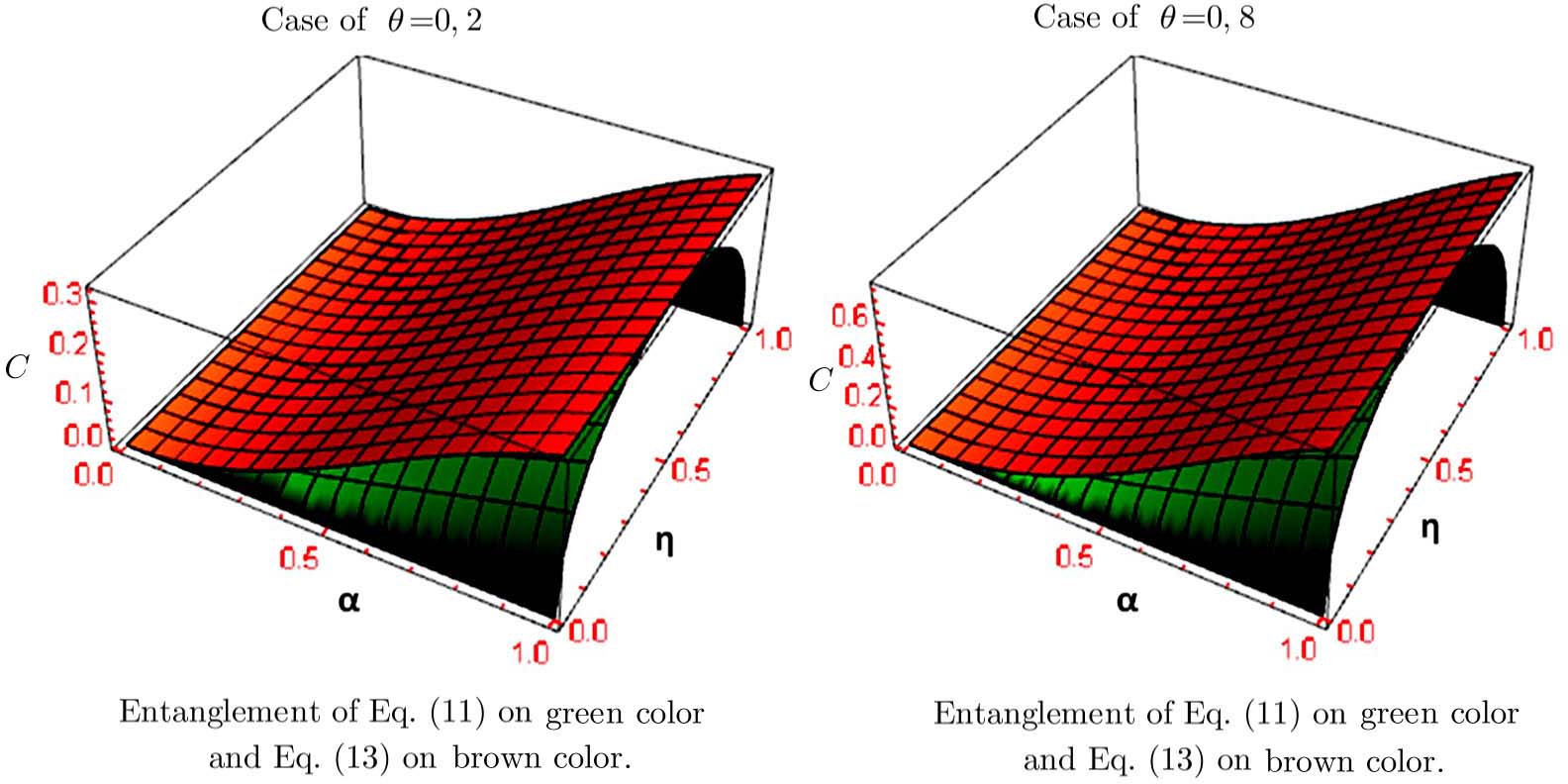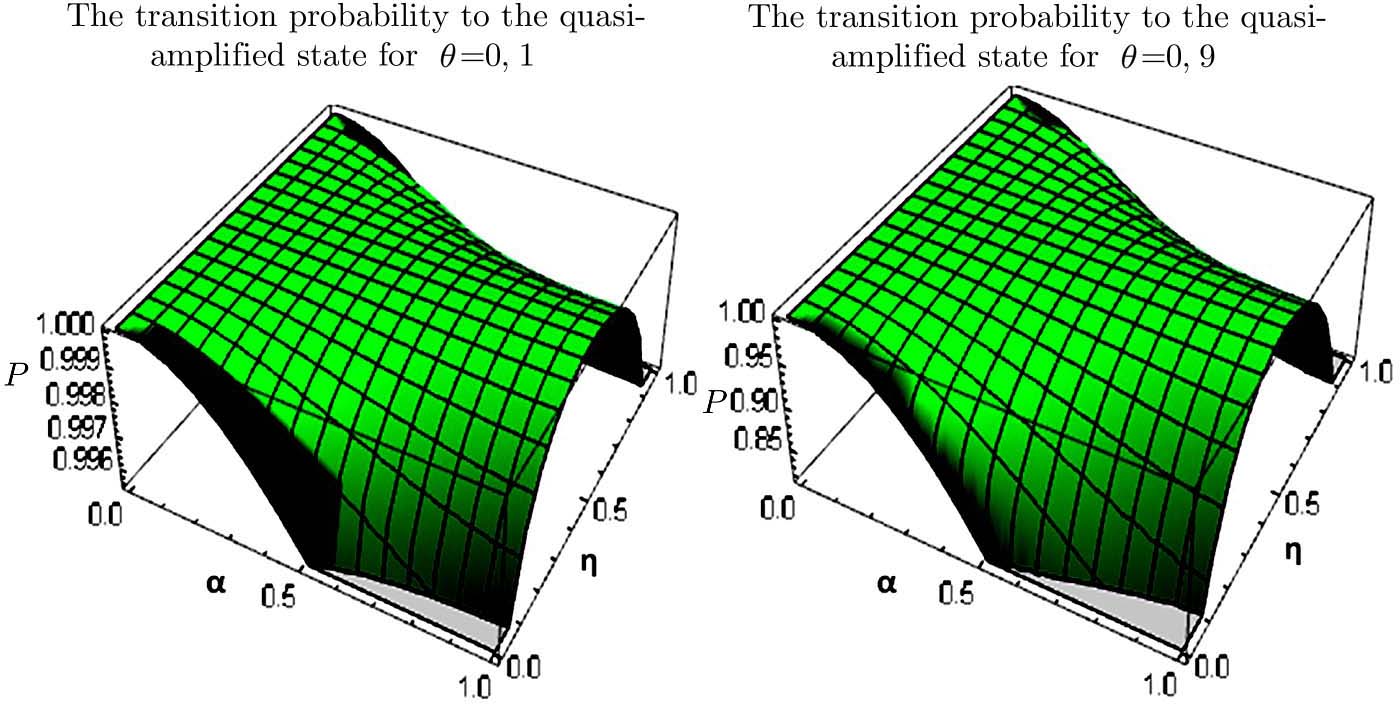† Corresponding author. E-mail:
We let a set of beam splitters of vacuum mode with a chosen transmittance parameter η in interaction with a separable coherent states. This model induces the production of an attenuated quantum channels based on entangled optical states. Indeed, the decoherence effect is exploited positively here to generate such kind of quantum channels. Next, the amplitude damping and the entanglement amount of these produced channels are enhanced thereafter by a probabilistic quasi amplification process using again a 50:50 beam splitter.
Optical coherent states are classical light fields with high purity, and are essential tools of information in optical areas. If these states, especially the entangled ones,[1–2] could be controlled in the quantum limit, then novel quantum-enhanced functions such as coherent-state quantum computing (CSQC),[3–4] quantum metrology,[5] and a quantum repeater[6–7] could be realized in the networks. Then, entangled coherent states have a large important applications that are investigated in several physical systems.[8–11]
Consider the case where some of quantum information (or classical parameter value) is encoded in the complex amplitude α of a coherent state ∣α⟩. If the state amplitude is made too small (generally by losses), then the strong overlap between different states can make it impossible to correctly distinguish among them. To make them exactly distinguishable for quantum information applications, including precision measurements,[12] quantum computation,[13] quantum teleportation[14] and quantum key distribution,[15] we need to amplify them with a good way on the limit of our need.
In this context, many works are focused on the amplification methods of coherent states with higher fidelity. For example, Ref. [16] has implemented a quantum setup containing interferometers, single-photon detectors and linear polarized fibers to achieve the amplification task. Reference [17] has realized the amplification of superposition of coherent states by using Beam splitters. References [18–19] have also realized this amplification using successive photon additions and photon subtractions (photon creation and annihilation operators). In addition, Ref. [20] has achieved a hybrid linear amplifier in order to establish a probabilistic cloning. In the same context, other works achieved a non-Gaussian encoding operations[21–23] to implement Error correction in the purpose of amplification.
Although, the above amplification protocols avoid working on the noisy limit due to the amplitude attenuation made by the noise effect. In other words, the noise gives rise to a phase uncertainty that plays an increasingly devastating role for the estimation of the phase as the excitation of the coherent states decreases. So, the state must be amplified in such a way that its phase variance is reduced as compared to the input state. Indeed, improving coherent states entanglement by its amplifications[24] is an interesting research field.
In the current work, we exploit positively the decoherence effect, to realize an entangled coherent states as quantum channels starting from separate ones, that is by using a symmetric decoherent noisy environment.[25–27] Indeed, the used decoherence model is based on the interaction of the signal with a beam splitters in a vacuum mode and a chosen transmittance parameter η. This corresponds to a Gaussian Error[28–29] implementation that will be helpful in our scheme to generate an attenuated quantum channels based on optical light.
After that, for the robustness of continuous variables quantum key distribution protocols, especially in the presence of an eavesdropper attacks using such quantum channels. We eliminate the photon losses and the amplitude damping caused generally by the noise effect as mentioned before. Then, we establish a quasi-amplification process of the realized entanglement, in a way that we can control the amplification rate. Otherwise, we discuss the attenuation process of the coherent states amplitude. To highlight the strength of our scheme, we study and analyze the behavior increase of the amplitude rate, the entanglement amount of the output entangled system after application of the proposed scheme. We analyze also the fidelity of the quasi-amplification process. Our protocol is useful in the production of either the quasi-amplified entangled coherent states or the attenuated entangled coherent states according to our need. We add that the protocol application is easier in the current technology because it needs only a simple light source as a diode laser and beam splitters (for decoherence effect and quasi-amplification process), knowing that the measurement will be efficient thanks to the homodyne detection of coherent light.
The decoherence effect model used in our work is realized by using the following process:
A Beam Splitter in the vacuum mode with a chosen transmittance parameter η in interaction with a coherent state ∣α⟩ causes a photon losses and an amplitude damping as follows:

We mention that the explanation of the overall steps of the used model is described initially in Fig.
Consider a qubit state initially inhabits in a coherent light b:

Secondly, we consider the fact that the two modes of the states ∣φ±⟩b and ∣ψ⟩a suffer both from the photon losses after crossing together two symmetric beam splitters of the vacuum mode as defined above in the decoherence model.
Then, we get:

If the two modes a and c of the whole system ∣T⟩ ⊗ ∣ϕ⟩c suffer both too from the photon losses after crossing together the symmetric noisy environment (Fig.









After that, we propose another measurement on the subsystems a, Ea, and 
Obviously, we have exploited our model of decoherence effect by beam splitters noise to produce four types of quantum channels. It includes an entanglement that has attenuated amplitudes, which is normal due to the noisy production tool. However, to improve these produced entangled states, we discuss in the next section a proposed model to enhance its quality by applying quasi-amplification.
In this section, we propose to increase the amplitude rate of the produced entangled coherent states that we have generated before. Also, an entanglement improvement is done for the same produced entangled state. For this purpose, we use a 50 : 50 beam splitter (the reflected beam which suffers a π/2 phase shift). After that, the fidelity of the quasi-amplification process is measured to highlight the strength of the protocol.
Consider the first case of Table
| Table 1
Different possibilities of produced attenuated quantum channels via decoherence effect after obtaining measurement outcomes on subsystems b and Eb. . |




We show in Fig.
 | Fig. 2 (Color online) Comparative study of the action effect of the Beam Splitter on each mode of the entangled state (11). |
This amplification behavior appears especially when the noise rate (the transmission parameter of the used beam splitter in the decoherence model) is 0 < η < 1/2, whatever the α > 0 value.
However, another amplification side is obtained otherwise in the mode Eb of Eq. (
We mention that with the same process, using the beam splitter as an optical device, we can amplify the other obtained attenuated entangled coherent states in Table
Now, to analyze the effect of our quasi-amplification scheme on entanglement, we measure the amount of entanglement of the input and the output entangled systems (Eqs. (
For this reason, to have orthogonal basis, we apply the following transformations:




After that, we plot in Fig.
To quantify the probability of transition from the input state in Eq. (
Signal of separate single coherent states are interacted with a beam splitters in the vacuum mode of chosen transmission parameter η. This proposed model causes an amplitude damping and photon losses. However, we exploit positively the decoherence effect of the model to produce an attenuated quantum channels. After that, to eliminate the amplitude attenuation that are caused by the noise effect, in such a way that its phase variance will be reduced, we propose an improvement model of the entanglement such as the amplitude rate.
Indeed, after using a beam splitter applied on the two modes of the entangled coherent state, we have succeeded to increase the entanglement amount of the produced entangled state as it is shown in Fig.
We notice that the quasi-amplification phase enhance the amplitude rate of our chosen mode in the entangled coherent light such as the entanglement amount. However, the best achieved increase of the entanglement amount is done when we use higher values of the parameter θ. Although, the probability of transition from the produced attenuated entangled state to the quasi-amplified state takes a good values when we use a low values of θ. Consequently, our scheme increases the amplitude rate, the entanglement amount with higher fidelity, but for reaching the maximum efficiency and higher improvement it is clearly recommended to use an intermediate values of θ.
| [1] | |
| [2] | |
| [3] | |
| [4] | |
| [5] | |
| [6] | |
| [7] | |
| [8] | |
| [9] | |
| [10] | |
| [11] | |
| [12] | |
| [13] | |
| [14] | |
| [15] | |
| [16] | |
| [17] | |
| [18] | |
| [19] | |
| [20] | |
| [21] | |
| [22] | |
| [23] | |
| [24] | |
| [25] | |
| [26] | |
| [27] | |
| [28] | |
| [29] | |
| [30] | |
| [31] | |
| [32] |








